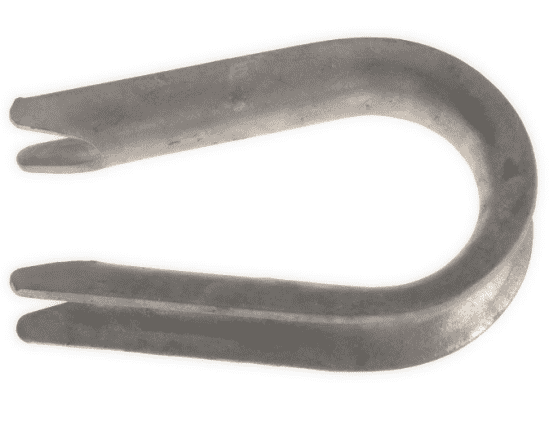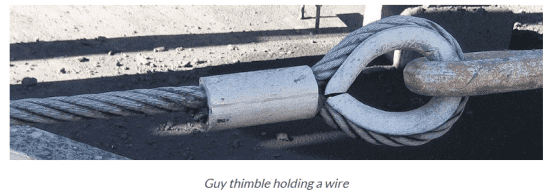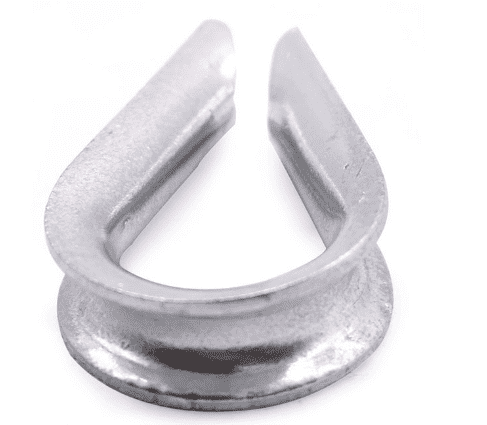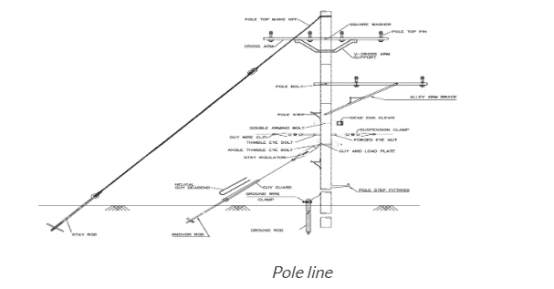Guy thimble is a pole line hardware designed for use on pole bands.
They work as an interface used to connect the guy wire or the guy grip.
This is common on dead end pole lines and electric power lines.

Apart from the uses mentioned above, the guy thimble connects the tension clamp to protect and support the ADSS/OPGW cable.
Most companies manufacture the cable thimble and assemble it as a very important accessory in pole line hardware.
Why You Need a Guy Thimble?
Whenever a wire is bent so that it can be connected to other components, there is a high risk of crushing.
A guy thimble is added to the eye to protect the rope as it provides extra support to the wire.
Besides that, it also guides the eye of the wire making a natural curve.

In addition, the guy thimble makes the application safer to use and also increases the durability of the rope.
Guy thimbles are available in a variety of materials and strengths.
The radius of the guy thimble is made in such a way that it increases the strength of the ropes.
The guy thimble is used together with ropes, turnbuckles, shackles and wire rope grips.
The components are attached to the guy thimble at different angles and positions.
For an efficient anchor, the positioning of the guy thimble and the accompanying components are to be taken seriously.
Technical Specifications of Guy Thimble
The guy thimble raw material is a steel sheet with different thicknesses. The punching machine cut the steel sheet into angular ends. The guy thimble has no sharp edges. Then the steel sheet is bent into the crescent-shaped main body. The surface treatment is hot dip galvanization according to ISO 1461. The galvanized surface is smooth and without burrs.
Some of the main technical specifications of guy thimble you should look for include:
Material Type
The type of material used in making guy thimbles include carbon steel and stainless steel.
Carbon steel is usually lighter and can rust as compared to stainless steel which is heavier.
To prevent it from rusting, the material used is hot dip galvanized offering an extra layer.
It can also be electro galvanized to make it corrosion resistant.
The strength of the material depends on the size of the material used.
Heavy gauge material is often stronger compared to the light gauge materials.
Coating technology
The coating is the application of a covering on steel to improve its ability to resist corrosion or as a decoration.
Guy thimbles are often coated through hot-dip galvanization, electro galvanization or painting.
Paint coatings are done to improve the image and also to increase its functionality.
The functionality improvements include wettability, adhesion, corrosion resistance and prevention from wear and tear.

ISO 1461 is an international standardization process that controls the process of galvanizing steel.
It states the requirements of hot dip galvanization of steel as compared to other forms of galvanization. I
n North America, galvanizers use ASTM A153 and A123 for products of steel and fasteners.
The customer has the freedom to choose the kind of ISO certification and the company is to respond by providing the right specifications.
Manufacturers should also know the slight differences between the two standards especially when it comes to testing the products.
Electro galvanization is another process that is used in coating the material used in making guy thimbles.
Zinc layers are usually bonded to steel to improve the ability to resist corrosion.
The process begins with zinc electroplating, maintaining a great position among other processes.
Weight
The weight of the guy thimble is dependent on the material used in making the product.
Steel is heavier and depending on the gauge of the material, it can be heavier.
The weight of the guy thimble will also vary depending on the task it is expected to perform.
There are quite a number of applications that require light gauge materials while others require heavy gauge material.
The dimensions of the guy thimble will also play a huge roll in determining the final weight.
Dimension
The dimensions on the guy thimble vary according to the kind of task it is expected to perform.
Normally, the manufacturer is responsible for providing the standard dimensions used in pole line technology.
The customer has the freedom of specifying the dimensions they require for their customized thimbles.
Also, the groove width is made depending on the size of the rope that is supposed to be used.
The wider the size of the rope, the wider the thimble will be.
Of course, the same principle applies to the overall length, width, and thickness of the thimble.
Normally, the groove width, overall length, width, inside length, width is measured in millimeters.
Design
Guy thimble comes in quite a number of shapes which include reeving thimble and the heart shaped thimble.
There are other shapes that can be seen in use in other applications such as the circular or ring guy thimbles.
Their design is also dependent on the type of connection it is expected to have.
The surface of the thimble is expected to be smooth to allow free movement of the wires and ropes used with it.
All edges are to be smooth enough to avoid the ropes from being cut.
Guy thimbles are to be flawless with no cracks on them to ensure efficient functioning.
Guy Thimble Manufacturing Process
The process of manufacturing the guy thimble is quite direct and easy.
Depending on the material used, you should be able to complete it if the necessary machines are available.
The most common raw materials include steel sheets of diverse thicknesses, punching machines, and cutting tools among others.

- Assemble all the material required and place them on a working bench. Steel sheets are supposed to be of different sizes depending on your requirements.
- The steel sheet is then bent and an internal contour is made. The resulting shape will resemble a pipe that has been cut vertically into two parts.
- The contour is very smooth and can be smoothened further to ensure they fit various sizes of the strand. The curved surface is usually meant to prevent the concentration of stress at particular points.
- Depending on the size of the strand to be used, there are quite a number of steel sheets that you can select to use.
- The punching machine is used in cutting the steel sheet into different angular ends with no sharp ends.
- The steel sheet is then bent again to a crescent shaped body before making it into a complete thimble. As the material is being bent, caution has to be taken not to break or crack the material.
This material is usually flexible and allows proper bending.
- The surface of the thimble is hot dip galvanized to make it corrosion resistant. Hot dip galvanization offers a tick coating to the steel and is often referred to zinc coating. Electro galvanization is another process that is usually used to coat the material.
How to Install a Guy Thimble
Installation of the guy thimble on a pole is a very complex process that requires the expertise of an experienced individual.
This includes safety precautions such as wearing safety boots, builders’ hardhats, protective clothing and goggles for the eyes.
You should also e ware of the overhead powerlines that may cause harm through electric shocks.
- Site selection is the first step of installation which includes ensuring the availability of enough space to raise the pole. The pole also requires enough anchorage so there must be enough space available for this purpose.
Measure the distance required between the pole and the anchors before raising the pole.
- Gather all the tools that are required for the process of installation of the guy thimble. Choose the material wisely as the installation may require different types of products.
- Install the base plate or the foot mount securely at the fixing points attaching the turnbuckles to the anchor points.
- To avoid stressing the pole structure, you should locate the guy anchors a distance away from the pole base.
- At this point, remove the shipping pin and small screw from the bottom and top of the pole respectively. Slide the top guy plate and top guy support from the pole and put them back in the opposite order.
- Screw the locks appropriately to ensure that the connections are strongly in place and will not be able to unmount.
- With the help of other people, raise the pole and make it stand in the base plate or foot mount.
- Attach the sets at the bottom to the turnbuckle anchors. Make them as tight as possible before checking the vertical using spirit level.
- An elevated work platform can be used to get to the desired height of the pole where the guy thimble will be installed.
Remember that the thimble is used in conjunction with ropes and cables so make sure it is tightened to the eye.
- Apart from that, ensure that it is sized perfectly as it may fall out of rotating if it is too loose. If the thimble is too oversized, it might not be able to fit the other connections. Make sure that the sizes of the connections used are matching.
- Use a set of pliers to twist open the thimble, and insert the other component before returning it to its normal shape. Small guy thimbles can be twisted using the hand while the heavy-duty thimbles will require the help of a vice and a pipe.

- After attaching the components to the thimble, tighten it well before attaching it to the pole. Make sure that the pole attachment is strong enough to hold the load attached to it.
Post time: Sep-17-2020
